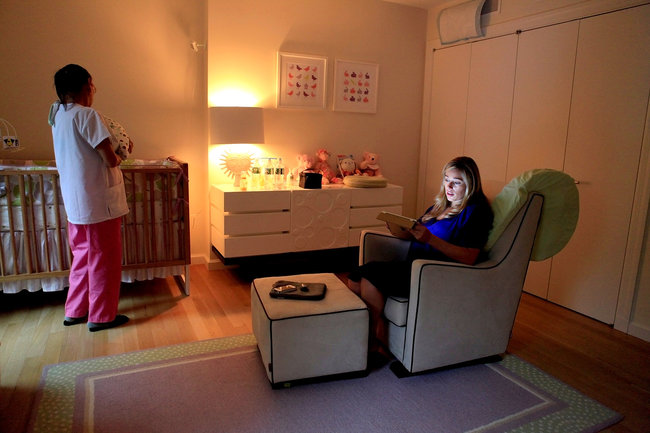Notes
Yahoo CEO Ushers in Rise of the SuperNewMom
We’ve all heard of a pregnant pause, but for some women, childbearing no longer means pausing one’s professional life. After tech rock star and incoming Yahoo CEO Marissa Mayer announced her pregnancy (and her intention to work through a truncated maternity leave), discussion ensued about the practicality and advisability of her choice. The New York Times, for example, profiled women like Maria Seidman (pictured above) whose professions and financial circumstances either require or enable the comingling of their maternal and professional responsibilities immediately after their babies are born.
The modern portrait of “supernewmomhood” seen here both replicates and challenges the dominant narrative about the uber successful CEO supermom—the woman made possible by the second generation of feminism but privileged enough to “have it all” in ways that her feminist foremothers could not. Ann Marie Slaughter’s much debated piece in The Atlantic sought to debunk the notion that even women who exist in the stratosphere of economic privilege can realistically “have it all,” and Rebecca Traister rightly pointed out that the “have it all” standard was unproductive—for women and for feminism. Nonetheless, the arguments in that debate are reflected visually in this photo.
First, the photo asserts that modern supernewmomhood is both orderly and tranquil. The well-stocked nursery is bathed in soothing sepia tones with nary a wet wipe out of place. In that respect, this photo is similar to society’s idealized portrait of new motherhood, in general. The chaos and lack of control experienced by many new moms is elided, suggesting that women whose lives fail to echo the pristine order of this nursery are simply falling short of expectations that “successful” women manage to fulfill.
Second, supernewmom reclines comfortably on a luxurious rocking chair and works on a lightweight tablet. The cumbersome trappings of an office are extraneous to supernewmom’s needs, suggesting that successful women do not require the office conveniences (a desk, a door, a quiet, well-lit workspace, and an assistant) that many of their non-mom counterparts enjoy.
The photo departs from the dominant narrative, however, with its admission that even the modern supernewmom cannot do it alone. Her hands are free to work thanks to the presence of a woman who certainly could be a friend or relative but appears, instead, to be a paid nanny—her hospital scrubs function as a uniform and her unpolished hairdo distinguishes her aesthetically from her surroundings, marking her as a temporary fixture of this privileged environment. Notably, like many working-class women, she goes unnamed in the New York Times’s photo caption.
Although the presence of the nanny signals economic privilege, it also is a visual correction of the assumption that supernewmoms go it alone. Childrearing has long been a cooperative endeavor. And not just between the baby’s parents. Women historically have relied on communities of other women—paid nannies or more often grandmas, aunts, sisters, and friends—to lighten the physical and psychological burdens of new motherhood. Elizabeth Cady Stanton—woman suffragist and mother of seven—once famously urged her (unmarried) friend Susan B. Anthony to “come here and I will do what I can to help you with your address if you will hold the babies and make the pudding.”
The presence of a breastfeeding pillow suggests that this mother has retained the material task of feeding her baby, but it is relegated to the background. Neither the pillow nor the baby captures the mother’s attention in this photo. Instead, her gaze is fixed on the glowing screen of her tablet, one of only two sources of light in the room. We cannot tell, from this picture, whether the scene is taking place at night or during the day time, suggesting that being a new mom and a CEO are both round-the-clock jobs.
Perhaps the most telling feature of this photo is how little space the baby occupies. The supernewmom narrative, itself, challenges the notion that a new baby “fills up” the mother’s (otherwise empty) life. Here, a new baby doesn’t even crowd the picture. Instead, the compliant, healthy, peaceful baby is tucked neatly into her or his assigned space. Life, unfortunately, is rarely so tidy.
— Karrin Anderson
Follow Karrin on Twitter at KVAnderson



Reactions
Comments Powered by Disqus